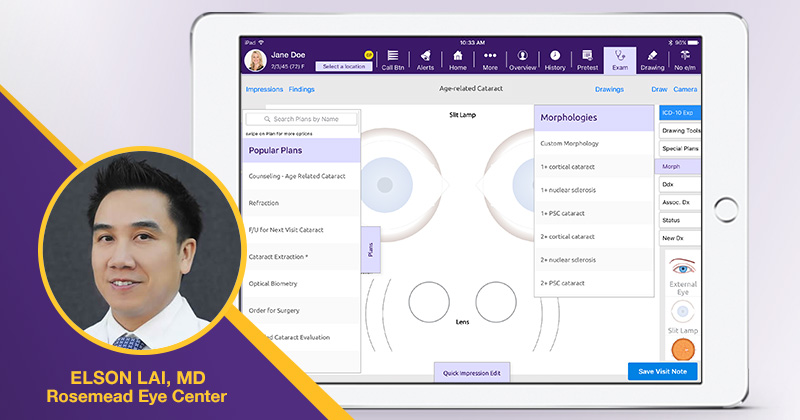In Record Time

Help improve efficiency in cataract surgery with an intuitive EMR system
This is a sponsored post by Modernizing Medicine and originally appeared in Ophthalmology Management.
I know a fair number of ophthalmologists who say electronic medical record (EMR) systems aren’t all they’re cracked up to be. Far from making things more efficient, these physicians argue, their EMR systems slow them down and make their job more time-consuming and complicated than they should be.
In my opinion, there are two major reasons for this sentiment. Habit is the first one; we’re all habitual creatures, and we don’t all necessarily like or take easily to change. Getting comfortable with an EMR system does take time. But, I believe a second reason is the strong possibility that these physicians simply haven’t equipped themselves with the right system for their practice.
When I first started my career as a cataract surgeon in 2011, health care was just beginning to switch over to EMRs. It wasn’t a smooth transition, to say the least. Although the patient’s history may have been in electronic format, current data and other information were still on paper, forcing many physicians to switch between paper based and electronic data. It was cumbersome, at best. To make matters worse, stage 1 and stage 2 EMR attestations were underway, and many EMR companies emerged for the sole purpose of getting in on the incentives being offered by the Centers for Medicare and Medicaid Services to help practices pay for EMR systems. Many of those companies have long since folded.
The ones with quality products still remain, however, and they are producing EMR systems that can help reduce the amount of time ophthalmologists and their staff spend on redundant, time-consuming paperwork in favor of more productive — and professionally rewarding —time spent caring for patients.
My EMR system, Modernizing Medicine’s EMA, was designed specifically for ophthalmology and can be used for virtually any of the field’s specialties, including cataract surgery. As a cloud-based system that can be accessed through my iPad, smartphone, or desktop computer, EMA eliminates the need for paper-based charts, which used to comprise my surgical caseload for the day. With EMA, I simply type the patient’s name into my iPad and the electronic folder with all the data I need pops up right there on the display, no matter where I am. If a patient or pharmacy calls after hours with a refill request, I don’t have to put them off until I can access the chart in my office; I can look it up right then and there on the EMA app.
Streamlined Surgery Scheduling
Speaking of surgical scheduling, our EMR system also streamlines much of that process. Once I order a surgery, all relevant case information — the patient’s name, location and date of the surgery, which eye is first, etc. — goes straight to my surgery scheduler without her having to ask for it. She simply looks at the file on our practice management system, which also provides insurance authorization and other requirements that may need to be met prior to the actual surgery.
Adaptive Learning Capability
As a cataract surgeon, I rely on various ‘standard operating procedures’ with respect to medication and other related aspects of cataract treatment. And another major benefit of my EMR system — one of its most significant with respect to saving time — lies in its adaptive learning capabilities. Indeed, it “remembers” the diagnoses I make most often and prepopulates the patient’s file with the medications and other treatment steps I am most likely to follow based on prior experience. Then I just need to keep, remove, or adjust according to my findings and diagnosis. For example, it will prepopulate my cataract surgery patients’ files with the steroids, anti-inflammatories and antibiotics that I prefer to use, along with their quantities and frequency. I just click on the diagnosis and the steps and treatments are already there. If I were an oculoplastic surgeon, my EMR would prepopulate the case forms with blepharochalasis, dermatochalasis, or orbital fractures.
EMR of the Future
I am now in my sixth year with EMA. As one of the software’s early adopters, I think more ophthalmologists will continue to acquire it because of how innovative and efficient it is. It’s fast at pulling up and processing patient data; I can access that data securely on any of my devices; and it’s absolutely seamless and easy to use for me and my staff. Quite honestly, I think it’s the EMR system of the future.
